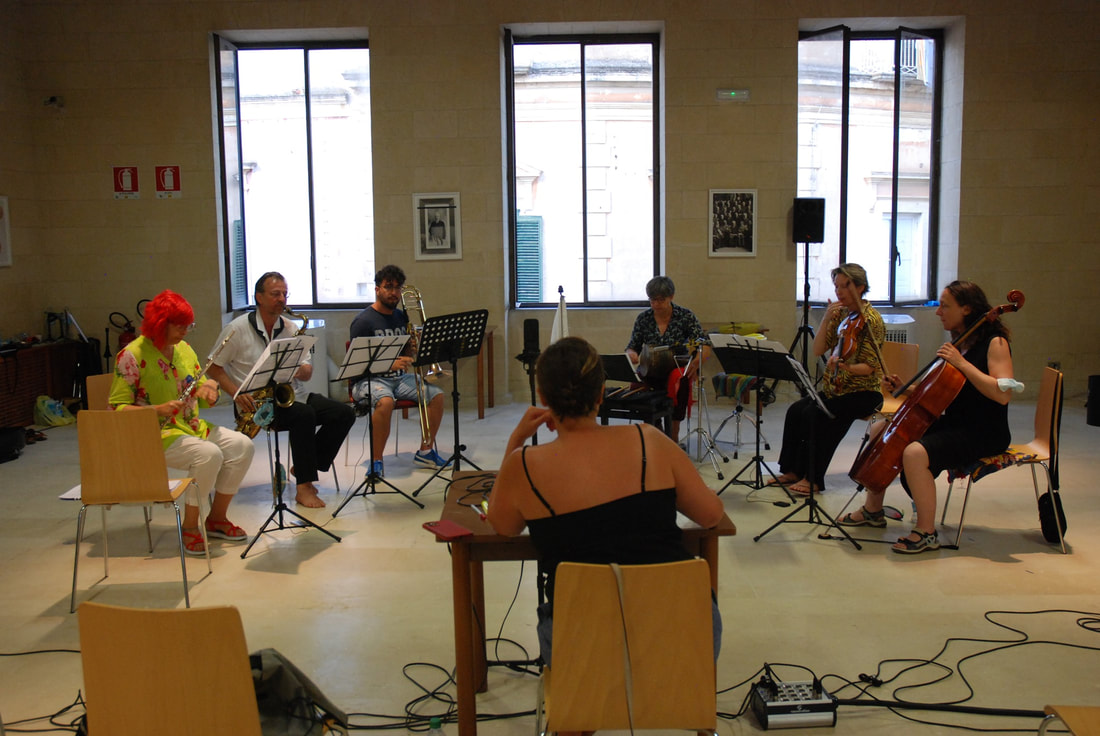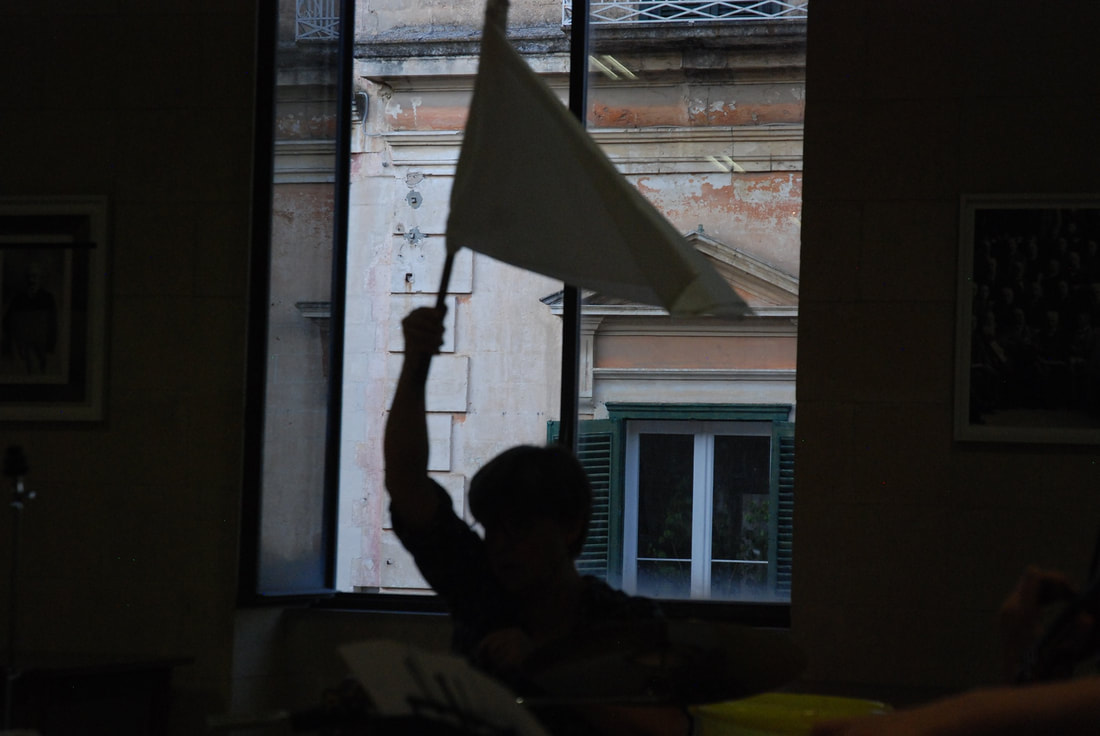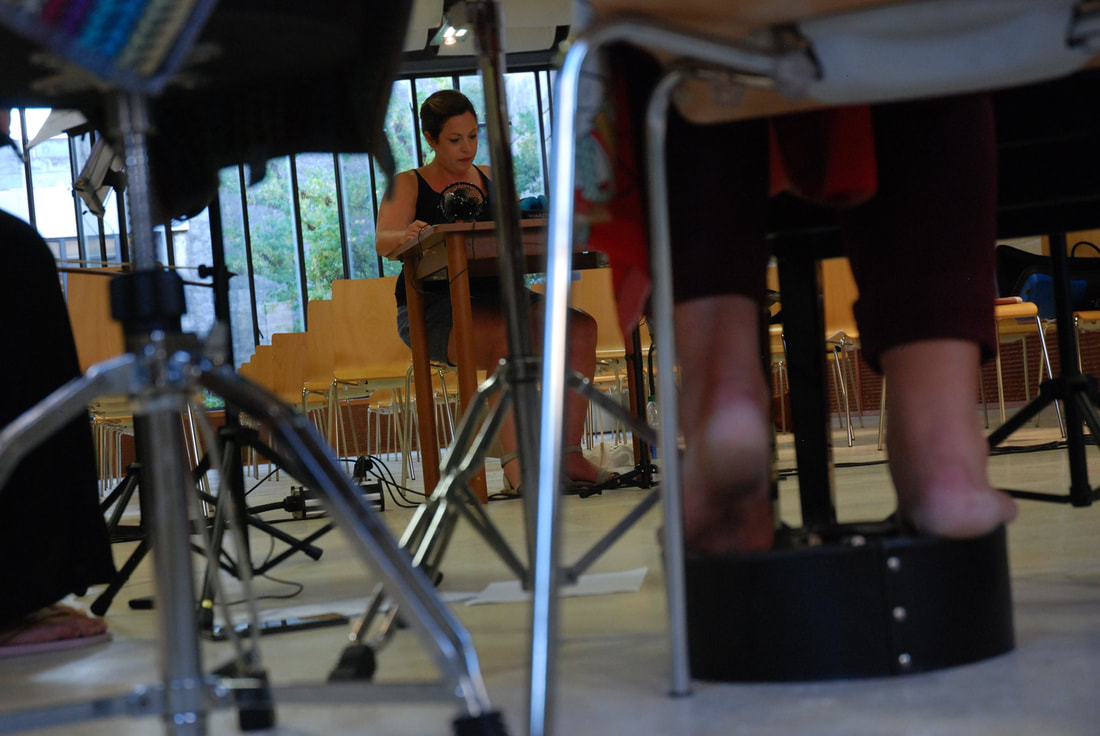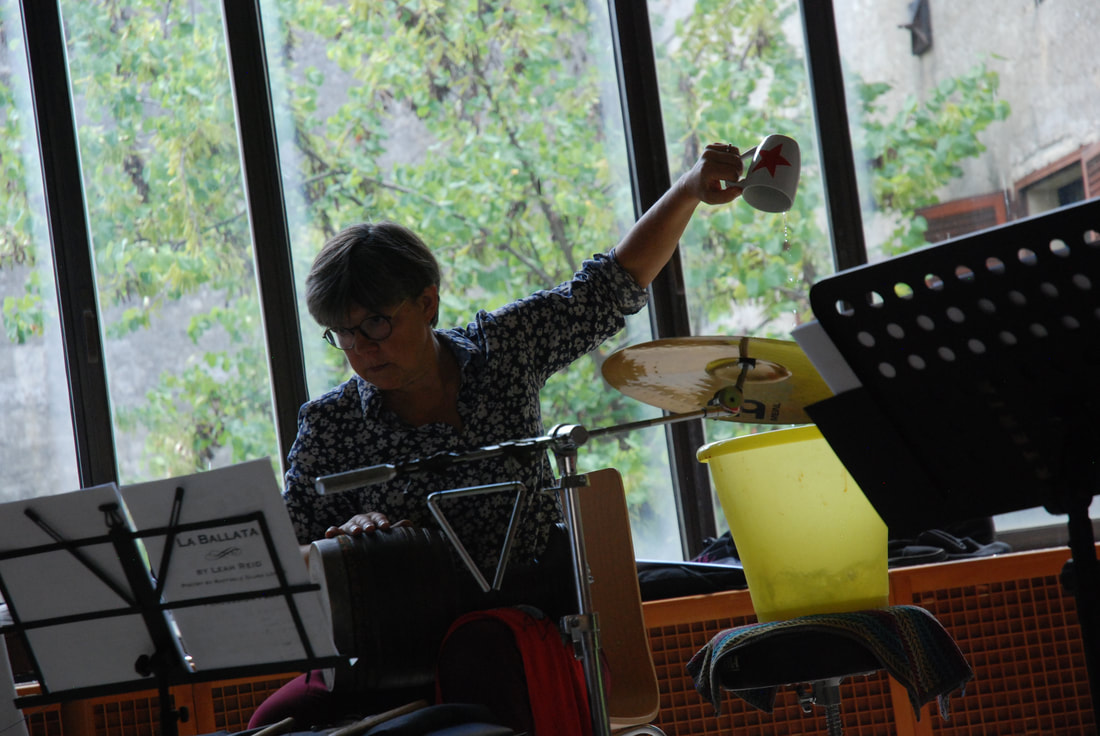Acoustic Music Samples
La Ballata
La Ballata, for flute, saxophone, trombone, percussion, violin, and cello, explores the sounds and rhythms present inside excerpts from the poem “La ballata della vucchiara ovvero tutto il miele è finito!” by Raffaele Giura Longo. Composers selected for the project were instructed to use the text in some way. The work was premiered in 2021 in Matera, Italy. The work is highly theatrical, and performers are directed to speak in addition to playing their instruments. The occasional prop is used. The work features an array of percussive sounds and phonetic textures. Many of the instrumental materials were derived through spectral analyses of the spoken text. These elements are juxtaposed with whole-tone sweeping gestures and modal/tonal melodic materials.
|
**Text Extracts**
“la ballata della vucchiara ovvero tutto il miele è finito!” by Raffaele Giura Longo Concavo è il favo ma è spesso convesso. E se il miele è dentro io c’entro, io c’entro! T’inguacchi le mani ma dentro rimani. Se spingi la faccia nessuno ti scaccia com’un cane vecchio. Io prendo un bel secchio: prima lo lavo, concàvo, concàvo; e quando s’è asciutto ci metto un prosciutto un po’ unto, un po’ spesso, convesso, convesso. Tutti quei massi mi sembrano i Sassi mi sembrano messi per esser concessi: non sono caverne, è facile averne e quelle grotte son tutte rotte. I Sassi son fatti per essere sfatti. Ma gli occhi con essi si fanno convessi, si fanno commossi, si fanno un po’ rossi. La macchia brucia, la Murgia scalcia, sul Parco sventola bandiera bianca. Ed alla fine chi vincerà per tutto il bene dell’umanità? Chiara Vucchiara, mi sembri ormai spoglia e ancora ne ho voglia! “Non c’era più cera, non più miele c’era!” La bocca concava ha solo la bava, la voce è fessa e solo convessa. La lingua scava fin nella lava e poi confessa di andare a messa. Ma san Pietro Barisano ci è sfuggito dalla mano e San Pietro Caveoso è piuttosto rumoroso; la Madonna della Bruna qui si assonna fino all’una; San Giovanni lava i panni e li asciuga con l’acciuga. ... Concavità Concavità! Dove è mai la felicità? E tu dolce mio convesso, dove mai ti hanno messo? (chi vuol far la rima adesso?) Vuoi vedere che alla fine non si trovan più le rime? Son finite tutte quante con Madonne, santi e sante. Ed allora andiamo via buona notte e così sia! |
**Translation**
Concave is the honeycomb but it's often convex. And if the honey is inside I go in! I go in! You're gonna get your hands dirty but inside you stay. If you push the face nobody's chasing you away like an old dog. I take a bucket: I wash it first, concave, concave; and when it's dry I put ham in it. a little greasy, a little thick, convex, convex. All those boulders they look like the Sassi. they seem to be put to be granted : they're not caves, it's easy to get those and those caves are all broken. The Sassi are made to be unmade. But the eyes with them become convex, they get moved, they get a little red. The shrubland burns, the Murgia kicks, on the Park it is waving a white flag. And finally who will win for mankind’s wellness? Clear Vucchiara, Now you look so empty, but I still want it! "There was no more wax, there was no more honey!" The concave mouth all it's got is slime, the voice is silly and just convex. The tongue burrows into the lava and then it confesses to go to mass. But Saint Peter Barisano slipped out of our hands. and San Pietro Caveoso is rather loud; the Madonna della Bruna sleeps here until one o'clock; St. John washes clothes and dries them with anchovies. ... Concavity Concavity! Where is happiness? And you, my sweet convex, where did they put you? (Who wants to rhyme now?) Can you see that in the end you can't find rhymes anymore? They're all finished with Madonnas and saints. And so, let's go away good night and so be it! |
Apple
Apple, for four sopranos, explores the sounds and rhythms present inside Gertrude Stein’s poem “Apple” from Tender Buttons.
The work contains eight sections that examine the poem from various angles. The work is highly theatrical, and the performers are directed to explore a vast repertoire of dramatic characters and singing styles.
The first section explores the phoneme /aep/ and a “normal” singing style; the second section explores percussive whispered and spoken consonants from “apple” through “shake”; the third explores spoken and Sprechstimme vowels from “apple” through “please”; the fourth explores half-sung syllables from “apple” through “no no gold”; the fifth section explores spoken/Sprechstimme/and sung words and word-clusters through “change sweet is”; the sixth section is the most melodious and explores “bready” through “kind of” with the melody, and “apple” through “please” in the accompaniment; the seventh section explores the entire poem moving from whispered through half-sung textures, examining “apple” until “ham”; and the 8th section focuses on the final phrase: “this is use”.
This work was commissioned by Accordant Commons and was written during a residency at the MacDowell Colony.
Tender Buttons
[Apple]
By Gertrude Stein
Apple plum, carpet steak, seed clam, colored wine, calm seen, cold cream, best shake, potato, potato and no no gold work with pet, a green seen is called bake and change sweet is bready, a little piece a little piece please.
A little piece please. Cane again to the presupposed and ready eucalyptus tree, count out sherry and ripe plates and little corners of a kind of ham. This is use.
The work contains eight sections that examine the poem from various angles. The work is highly theatrical, and the performers are directed to explore a vast repertoire of dramatic characters and singing styles.
The first section explores the phoneme /aep/ and a “normal” singing style; the second section explores percussive whispered and spoken consonants from “apple” through “shake”; the third explores spoken and Sprechstimme vowels from “apple” through “please”; the fourth explores half-sung syllables from “apple” through “no no gold”; the fifth section explores spoken/Sprechstimme/and sung words and word-clusters through “change sweet is”; the sixth section is the most melodious and explores “bready” through “kind of” with the melody, and “apple” through “please” in the accompaniment; the seventh section explores the entire poem moving from whispered through half-sung textures, examining “apple” until “ham”; and the 8th section focuses on the final phrase: “this is use”.
This work was commissioned by Accordant Commons and was written during a residency at the MacDowell Colony.
Tender Buttons
[Apple]
By Gertrude Stein
Apple plum, carpet steak, seed clam, colored wine, calm seen, cold cream, best shake, potato, potato and no no gold work with pet, a green seen is called bake and change sweet is bready, a little piece a little piece please.
A little piece please. Cane again to the presupposed and ready eucalyptus tree, count out sherry and ripe plates and little corners of a kind of ham. This is use.
Single Fish
Single Fish is an aphoristic composition for three sopranos and hand percussion. The work explores the sounds and rhythms present inside Gertrude Stein’s poem “Single Fish” from Tender Buttons. The piece is divided into four sections, each examining a subset of the text. The singers are directed to explore a vast repertoire of theatrical characters and singing styles. The composition begins with delicate whispered and spoken phonetic textures and slowly incorporates pitched material: ranging from honky-tonk piano imitations to lush melodic lines.
Text for Single Fish:
Tender Buttons
[Single Fish]
By Gertrude Stein
Single fish single fish single fish egg-plant single fish sight.
A sweet win and not less noisy than saddle and more ploughing and nearly well painted by little things so.
Please shade it a play. It is necessary and beside the large sort is puff.
Every way oakly, please prune it near. It is so found.
It is not the same.
Text for Single Fish:
Tender Buttons
[Single Fish]
By Gertrude Stein
Single fish single fish single fish egg-plant single fish sight.
A sweet win and not less noisy than saddle and more ploughing and nearly well painted by little things so.
Please shade it a play. It is necessary and beside the large sort is puff.
Every way oakly, please prune it near. It is so found.
It is not the same.
Occupied Spaces
Occupied spaces is a piece that explores timbre through a series of 11 ‘rooms’ or spaces. Some of these spaces have been modeled after physically existing rooms, others are either imagined (and do not follow the rules of physics), or occur inside your head. There are three impulses in the piece: a zipper, a clap and a balloon pop that are inserted into these rooms. These three sounds have been filtered to various degrees and, over the course of the piece, frequencies are added to the impulses, creating an increasingly noisy texture.
The piece has six sections and an introduction. The sections determine not only which rooms are presented, but also the degree of the pitch-to-noise ratio present at any given time. In each section, impulses have been organized into various strands of material. Each strand comes from a two part theme that is presented in the first section. Each section takes this theme and destructively varies it. The piece begins with an introduction of the zipper that hints at some of the characteristics of the rooms, followed by section 1 that presents rooms 1-4 and the basic two strands of thematic material. Section 2 introduces rooms 5 and 6 and the strands begin to grow and overlap. Section 3 presents rooms 7 and 10 and the possibility of 3 simultaneous strands and 2 overlapping rooms. Section 4 introduces room 8, and strands begin to multiply and deteriorate the rooms. The zipper attempts to intervene, but is repetitively stopped by room 8. Section 5 begins after a final failed attempt of the zipper to break free, followed by the first iteration of room 9. The material tentatively resets; however, the rooms have deteriorated and reflections begin to multiply. The strands multiply and grow and the reflections densify until they have completely saturated all of the rooms. A final iteration of the clap, balloon and zipper form the climax of the piece. Section 6 is marked by the second iteration of room 9, which takes the final climactic impulse and leads the listener into the final new room: # 11 - a resonant soup and ghost of the previously heard impulses. This final room reminisces with a small band-width of frequencies from the previously heard impulses. The piece closes with a brief recapitulation and final presentation of fragments of the original theme and a brief presentation of select rooms.
The piece has six sections and an introduction. The sections determine not only which rooms are presented, but also the degree of the pitch-to-noise ratio present at any given time. In each section, impulses have been organized into various strands of material. Each strand comes from a two part theme that is presented in the first section. Each section takes this theme and destructively varies it. The piece begins with an introduction of the zipper that hints at some of the characteristics of the rooms, followed by section 1 that presents rooms 1-4 and the basic two strands of thematic material. Section 2 introduces rooms 5 and 6 and the strands begin to grow and overlap. Section 3 presents rooms 7 and 10 and the possibility of 3 simultaneous strands and 2 overlapping rooms. Section 4 introduces room 8, and strands begin to multiply and deteriorate the rooms. The zipper attempts to intervene, but is repetitively stopped by room 8. Section 5 begins after a final failed attempt of the zipper to break free, followed by the first iteration of room 9. The material tentatively resets; however, the rooms have deteriorated and reflections begin to multiply. The strands multiply and grow and the reflections densify until they have completely saturated all of the rooms. A final iteration of the clap, balloon and zipper form the climax of the piece. Section 6 is marked by the second iteration of room 9, which takes the final climactic impulse and leads the listener into the final new room: # 11 - a resonant soup and ghost of the previously heard impulses. This final room reminisces with a small band-width of frequencies from the previously heard impulses. The piece closes with a brief recapitulation and final presentation of fragments of the original theme and a brief presentation of select rooms.
Clocca
|
Clocca is a piece that explores sounds associated with time. The latin title, meaning ‘bell,’ is a precursor to the english word ‘clock,’ and is meant to illustrate the intimate connection between time, clocks, and bells. The overarching form of the piece is a retrograde of the bell sound, followed by an original bell sound. The bell’s individual partials act as a structuring mechanism throughout the piece. Other bell sounds also commonly associated with time and bells were used.
The composition itself is highly concerned with the exploration of contrasting timbres. Perceptual timbre studies were used to create a generalized composition model, which was then in turn used as a structuring mechanism for the piece. The piece approaches timbre from both a vertical and horizontal perspective. |
|
Ostiatim
Through a series of fifteen fragments, Ostiatim explores the sounds produced by doors and the emotional inflections of the people who interact with them. Examples of sounds include: doorchimes, westminster doorchimes, knocking, doors banging, slamming, and doors creaking.
The title, meaning “door-to-door,” is meant to depict the timeline of the piece. Each fragment should be treated like a fleeting memory--sometimes connections are made, and other times the moment slips away.
The composition was inspired by artist Anish Kapoor’s sculpture: Memory and explores the concept of timbre space and timbre as a morphing device for exploring new material.
The title, meaning “door-to-door,” is meant to depict the timeline of the piece. Each fragment should be treated like a fleeting memory--sometimes connections are made, and other times the moment slips away.
The composition was inspired by artist Anish Kapoor’s sculpture: Memory and explores the concept of timbre space and timbre as a morphing device for exploring new material.
Pear
Pear is a piece composed for two violins (or a pair) that illustrates both the similarities and differences between instruments and performers. Through six movements the piece explores an expanded range of the instrument, as well as a variety of extended techniques and dynamics. As a metaphor, the violin combines the melodic and textural passages to depict the connection between instruments and the individuality of the people who play them.
Forged
|
Forged is a one movement piece written for the Sound Gear Ensemble. The title refers to the process of blacksmithing and acts as a metaphor for several processes which occur throughout the composition. The piece is chromatic in nature and was composed using a series of connected block structures that are interwoven, obscured and then decomposed. The five traditional Japanese elements of Chi (Earth), Ka (Fire), Fū, (Wind), Sui (Water), and Kū (Void) are essential to the art of blacksmithing, and each provide unique contributions to the construction, texture, and color of Forged. For example, the concept of void is represented through the insertion of silence throughout the piece, and water is depicted through a “ripple effect” patterning of material. Forged continues Reid’s exploration of musical textures, extended techniques, and instrumental timbres.
|
|
Blink
Blink, for accordion, clarinet, and electric guitar, is a short piece that explores “musical images,” tiny moments and events, the concept of focus, suddenness, and re-calibration.



